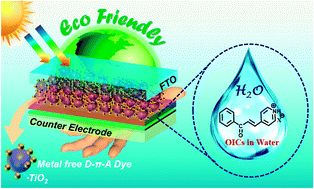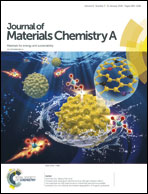Low toxicity environmentally friendly single component aqueous organic ionic conductors for high efficiency photoelectrochemical solar cells†
Abstract
Photoelectrochemical solar cells have gained impetus over the past two decades owing to several advantages over conventional Si solar cells. The redox capabilities of the electrolyte play a major role in determining the overall photo-conversion efficiency (PCE) of dye sensitized solar cells. In this work we report a novel low toxicity and environmentally friendly aqueous organic ionic conductor (AOIC) for high efficiency DSSCs. This study presents the effect of water on the photocurrent density (Jsc) and stability of DSSCs. Interestingly we have also found that the addition of water to the OICs strongly alters the flat band potential (Efb) of nano-crystalline TiO2, hinders the recombination at the TiO2–AOIC interface and positively shifts the redox potential of I−/I3−. Under 1 sun illumination, OICs with 3-methoxypropionitrile solvent and OICs in water show a PCE of 6.02% and 3.57% respectively. This reduced PCE and J–V characteristics are attributed to the negative influence of water on the electron lifetime, electron recombination kinetics and the dark current. Substituting the electron withdrawing group present in the para-position of pyridinium salts mitigates the toxicity and enhances the cationic effect in the electrolyte. The DSSCs fabricated using AOICs showed excellent stability for more than 20 days.



 Please wait while we load your content...
Please wait while we load your content...